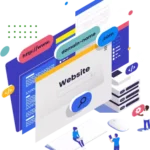
by dev.onepoundsite | Mar 21, 2024 | Website Design
🌟 Elevate Your Online Presence! 🌟
Are you ready to take your business to the next level? Look no further! Our comprehensive suite of services covers everything you need for a successful online presence – from stunning website design to reliable domain hosting and hassle-free maintenance.
🚀 Professional Website Design: Your website is often the first impression potential customers have of your business. Make it count with our expertly crafted designs tailored to your brand identity and optimized for user experience. Stand out from the crowd and leave a lasting impression.
💻 Domain & Hosting Solutions: Secure your online identity with our seamless domain registration services. Choose from a wide range of domain options that reflect your business name and vision. Plus, with our reliable hosting solutions, you can trust that your website will always be up and running smoothly, ensuring maximum uptime for your visitors.
🔧 Effortless Maintenance: Focus on what you do best – running your business – while we take care of the technical details. Our dedicated team will handle all aspects of website maintenance, including updates, backups, and security checks, so you can have peace of mind knowing your site is in good hands.
Why choose us?
✅ Experienced professionals with a proven track record
✅ Tailored solutions to meet your specific business needs
✅ Transparent pricing with no hidden fees
✅ Exceptional customer support every step of the way
Don’t let your competitors steal the spotlight – invest in your online presence today and watch your business thrive! Contact us now to learn more about our Business Website Design, Domain-Hosting, and Maintenance services.
Contact Now:
📞 +44 7870 534777
📩 support@onepoundsite.co.uk
🗣 Special Discounted Business Websites Design Packages and Prices- https://onepoundsite.co.uk/
🗣 Special Discounted Hosting Packages and Prices-
👀👉 Click Here https://onepoundhost.co.uk/
#OnlinePresence
#ProfessionalDesign
#domainhosting
#EffortlessMaintenance
#businesssuccess

by dev.onepoundsite | Feb 6, 2024 | Website Design
So, you’ve got an idea bubbling in your brain, a message to share with the world, or a business yearning for an online presence. Fantastic! But before you dive headfirst into the world of web design, it’s crucial to gather the essential tools and knowledge. Think of it like embarking on an exciting road trip – you wouldn’t leave without a map, snacks, and a reliable vehicle, right? This blog post serves as your comprehensive roadmap, guiding you through the key ingredients needed to design a website that wows.
Step 1: Charting Your Course – Defining Your Goals and Target Audience
Before unleashing your creative spirit, take a moment to reflect on your website’s purpose. What do you want to achieve? Is it to sell products, showcase your portfolio, or simply connect with like-minded individuals? A clear understanding of your goals acts as your compass, guiding design decisions and ensuring your website resonates with the right audience.
Next, identify your target audience. Who are you trying to reach? Understanding their demographics, interests, and online behavior will help you tailor the website’s tone, style, and content to their preferences. Imagine building a bridge – you design the access points based on who needs to cross it.
Step 2: Laying the Foundation – Choosing the Right Tools and Platform
Now that you know your destination and passengers, it’s time to pick your chariot. Here are the crucial elements for laying a solid foundation:
- Domain Name: This is your website’s unique address on the internet, your virtual storefront’s sign. Choose a name that’s memorable, relevant to your brand, and easy to spell.
- Web Hosting: Think of this as the rented space where your website’s files reside, accessible to visitors worldwide. Choose a reliable hosting provider with features that match your website’s needs.
- Website Builder/Content Management System (CMS): This is your website’s construction kit, allowing you to build and manage its content. For beginners, user-friendly website builders like Wix or Squarespace offer drag-and-drop interfaces and pre-designed templates. More experienced users might opt for open-source CMS platforms like WordPress for greater flexibility and customization.
Step 3: Building the Architecture – Structuring Your Website
With the foundation laid, it’s time to design the blueprint of your website. Information architecture refers to how you organize your content and pages, making it easy for users to navigate and find what they’re looking for. Here are some key elements:
- Sitemap: This visual representation of your website’s structure acts as a roadmap for both users and search engines.
- Navigation: Design clear and intuitive menus that allow users to effortlessly explore different sections. Think drop-down menus, breadcrumbs, and search bars for added convenience.
- Wireframing: Create low-fidelity sketches of your page layouts to visualize the hierarchy of information and user flow before diving into design.
Step 4: Painting the Picture – Design Principles and User Experience (UX)
Now comes the fun part – dressing up your website! But remember, aesthetics go hand-in-hand with functionality. Here are some design principles to keep in mind:
- Simplicity is key: Avoid clutter and overwhelming users with too much information or visual elements.
- Visual hierarchy: Use elements like size, color, and contrast to guide users’ eyes towards important information.
- Responsiveness: Ensure your website adapts seamlessly to different screen sizes and devices, providing an optimal experience for everyone.
- Accessibility: Make your website accessible to users with disabilities by following WCAG guidelines, ensuring everyone can access your content.
Remember, UX is paramount. Consider how users interact with your website, anticipating their needs and making their journey smooth and intuitive. Test your design with real users to gather feedback and iterate based on their experiences.
Step 5: Filling the Shelves – Content is King
With a stunning design in place, it’s time to stock your website’s shelves with engaging content. Remember, high-quality, informative, and relevant content is what keeps users coming back for more. Here are some content essentials:
- Compelling copy: Write clear, concise, and engaging text that resonates with your target audience.
- Visually appealing images and videos: Break up text with relevant visuals that enhance your message and grab attention.
- Calls to action (CTAs): Tell users what you want them to do next, whether it’s subscribing to your newsletter, purchasing a product, or contacting you.
- SEO optimization: Optimize your website’s content and structure for search engines to increase its visibility in search results.
Step 6: Grand Opening – Launching and Maintaining Your Website
Congratulations! You’ve built your website from the ground

by dev.onepoundsite | Feb 6, 2024 | Website Design, Wix
Building a website can be daunting, especially when faced with seemingly endless options and the fear of hefty price tags. Wix, the popular drag-and-drop website builder, often pops up as an attractive solution, boasting the allure of “completely free.” But before you dive headfirst into Wix’s world, it’s crucial to understand the true cost behind this “free” service.
The Glimmering Facade of Free:
Wix確實提供免費計劃,讓您構建基本網站,添加文本、图像、视频等。 乍一看,这似乎是夢寐以求的交易—免费拥有网站! 然而,就像大多数“太好而不真实”的优惠一样,这里也有一些需要注意的隐藏成本。
Firstly, your free website will sport a subdomain like “<invalid URL removed>,” not a professional-looking custom domain (e.g., <invalid URL removed>). This can hinder your brand identity and credibility. Secondly, Wix ads will be plastered across your site, detracting from your content and subtly reminding you that you’re using a free service.
While the free plan allows basic functionality, it severely limits your website’s potential. Features like accepting online payments, integrating marketing tools, and removing storage restrictions are locked behind premium plans, ranging from $16 to $59 per month. These costs can quickly add up, especially for businesses or those seeking advanced functionalities.
Beyond Monetary Costs:
The limitations of the free plan extend beyond financial constraints. Bandwidth and storage are capped, restricting your website’s growth and scalability. Additionally, certain design elements and app integrations are unavailable, hindering your ability to fully customize your website and cater to your specific needs.
Furthermore, Wix reserves the right to modify your free website’s code, potentially affecting its functionality and SEO performance. You also lack access to priority customer support, meaning troubleshooting issues might take longer.
Is Wix Really for You?
Despite the limitations, Wix’s free plan remains a valuable tool for specific situations. It’s perfect for experimenting with website creation, building a personal portfolio, or showcasing basic information. However, if you envision a professional, feature-rich website, especially for business purposes, the free plan becomes more of a restriction than a benefit.
Alternatives to Consider:
Several competitors offer Freemium models similar to Wix. However, each platform caters to different needs and comes with its own set of limitations. Here’s a quick overview:
- WordPress.org: Offers unparalleled flexibility and customization but requires web hosting and technical knowledge.
- Squarespace: Similar to Wix in ease of use but can be more expensive for larger websites.
- Webflow: Powerful design capabilities but steeper learning curve and higher pricing.
The Bottom Line:
Wix’s free plan can be a stepping stone, but understanding its limitations is crucial. Weigh your website’s needs and goals carefully before committing to the free plan. If you envision a professional, fully functional website, consider the long-term costs and explore alternative platforms that might better suit your requirements. Remember, sometimes “free” comes with a hidden price tag that can hinder your website’s potential.
Additional Tips:
- Clearly define your website’s purpose and target audience before choosing a platform.
- Consider future growth and scalability when evaluating available plans.
- Explore alternative platforms and compare features, pricing, and ease of use.
- Don’t be afraid to invest in your website; it’s your online storefront and brand ambassador.
By carefully considering these factors, you can make an informed decision about building your website, ensuring it truly serves your needs and thrives in the digital landscape.

by dev.onepoundsite | Feb 6, 2024 | Website Design
The internet beckons, a blank canvas waiting to be filled with your ideas, your story, your brand. But before you embark on the exciting journey of building your website, a crucial question arises: can you truly design a website for free?
The answer, like many things in life, is not a simple yes or no. It depends on your goals, your technical prowess, and the level of professionalism you desire. Let’s delve deeper into the world of free website design, exploring the trade-offs and uncovering the perfect fit for your needs.
The Enticing Allure of Free Website Builders:
Free website builders like Wix, Weebly, and WordPress.com are like sirens, luring you in with their user-friendly interfaces, drag-and-drop tools, and the promise of a website without breaking the bank. These platforms offer a plethora of templates, allowing you to quickly whip up a basic website without needing to write a single line of code.
The (Not-So-Hidden) Costs of Free:
However, the “free” label comes with asterisks. While you might not pay directly for the software, you’ll encounter limitations that can impact your website’s functionality, aesthetics, and professionalism. Here are some key trade-offs to consider:
- Limited design flexibility: Free templates often restrict customization options, making it difficult to achieve a truly unique and branded look.
- Subdomain blues: Your website address will likely include the platform’s name (e.g., <invalid URL removed>), which looks less professional than a custom domain.
- Annoying ads: Free plans often plaster ads on your website, distracting visitors and undermining your brand image.
- Storage and bandwidth constraints: Free plans often come with limited storage and bandwidth, which can hinder your website’s growth and performance.
- Limited features and functionality: You might miss out on essential features like e-commerce, SEO tools, and analytics, hindering your website’s potential.
The DIY Route: Free Software and the Learning Curve:
If you’re comfortable with code and don’t mind a steeper learning curve, free software like WordPress.org and HTML/CSS offer complete control over your website’s design and functionality. However, this path requires technical expertise, time investment, and the need for additional resources like web hosting and a custom domain.
Beyond Free: Exploring Paid Options for Greater Freedom:
For those who prioritize design flexibility, professional branding, and advanced features, paid website builders and custom development offer a world of possibilities. Paid plans typically eliminate limitations, provide custom domain options, and offer robust features like e-commerce, SEO tools, and analytics. Additionally, hiring a web developer can unlock a truly unique and personalized website, but be prepared for the associated costs.
So, Can You Design a Website for Free?
Ultimately, the answer lies within your goals, skills, and budget. If you’re building a simple personal website or portfolio, a free website builder might suffice. However, for professional businesses, e-commerce ventures, or websites requiring specific functionalities, paid options offer greater control and scalability.
Finding the Perfect Fit: A Checklist for Your Website Journey:
Before embarking on your website creation journey, consider these questions:
- What is the primary purpose of your website?
- Who is your target audience?
- What level of design customization do you need?
- Do you require advanced features like e-commerce or analytics?
- What is your technical skill level and comfort with coding?
- What is your budget for website design and development?
By carefully considering these factors, you can chart the right course for your website, whether it’s navigating the free options with their trade-offs or investing in paid solutions for greater control and professionalism. Remember, your website is a reflection of your brand, your voice, and your online presence. Choose the path that empowers you to create a website that truly shines!

by dev.onepoundsite | Feb 6, 2024 | Website Design
Imagine your website as your digital storefront, your online business card, or even your personalized billboard. It’s the first impression you make on potential customers, collaborators, or simply the world. So, how do you ensure this impression is captivating, informative, and uniquely you? Designing a website that shines might seem daunting, but fret not! This guide will equip you with the knowledge and practical steps to navigate the exciting world of web design.
Setting the Stage: Defining Your Goals and Audience
Before diving into aesthetics, understand why you need a website. Are you showcasing your portfolio, promoting a business, or building a community? Defining your goals helps tailor your design to resonate with your target audience. Who are they? What information do they seek? What emotions do you want to evoke? Empathy plays a key role here. Visualize your ideal visitor and craft a website that caters to their needs and preferences.
Building the Foundation: Choosing the Right Platform
Now, let’s talk tools. Numerous website builders and content management systems (CMS) cater to different skill levels and needs. Wix and Squarespace offer user-friendly drag-and-drop interfaces, ideal for beginners. If you’re comfortable with coding, platforms like WordPress offer more flexibility and customization. Research and compare features, pricing, and ease of use to find the perfect fit.
Content is King (and Queen): Planning Your Website’s Architecture
What stories will your website tell? Start by planning your content like a captivating book. Identify essential pages like “About Us,” “Services,” or “Contact.” Consider including blog sections, portfolios, or testimonials to add depth and engagement. Sketch out a sitemap to visualize the information hierarchy and user flow. Remember, navigation should be intuitive and effortless. Every click should lead visitors closer to their desired information or action.
Visual Appeal: Design Elements that Dazzle
Now comes the fun part: dressing up your website! Choose a color palette that reflects your brand identity and evokes the desired emotions. Think calming blues for a spa website or vibrant oranges for a children’s store. High-quality visuals are crucial. Opt for professional photos, illustrations, or videos that align with your content and brand. Remember, white space is your friend. Don’t clutter your design; let key elements breathe and shine.
Typography: The Unsung Hero of Readability
Words are powerful, but their presentation matters. Choose fonts that are easy to read on various devices and screen sizes. Sans-serif fonts like Arial or Open Sans are popular choices for their clarity. Maintain consistency in font styles and sizes to create a sense of visual hierarchy and organization. Don’t underestimate the power of well-chosen typography to enhance readability and user experience.
Optimization: Making Your Website Shine in the Search
Search Engine Optimization (SEO) ensures your website is easily discoverable online. Utilize relevant keywords naturally throughout your content and meta descriptions. Optimize page titles and image alt tags. Consider mobile-friendliness, as Google prioritizes websites that offer a seamless experience on all devices. By implementing these practices, you increase your website’s visibility and attract more organic traffic.
Accessibility: Welcoming Everyone to Your Digital Space
Remember, your website should be accessible to everyone, regardless of ability. Use alt text to describe images for visually impaired users. Employ clear and concise language. Ensure your website functions well with assistive technologies like screen readers. By prioritizing accessibility, you create a more inclusive and welcoming online space.
The Final Touches: Testing, Launch, and Beyond
Before unleashing your masterpiece to the world, test it thoroughly on different devices and browsers. Ensure all links work, pages load quickly, and the user experience is smooth. Once launched, celebrate your accomplishment! But remember, your website is a living entity. Keep adding fresh content, engaging with your audience, and monitoring analytics to optimize performance. Continuously adapt and evolve to stay relevant and engaging in the ever-changing digital landscape.
Wrapping Up: Your Website Awaits!
Designing a website might seem like a complex endeavor, but with the right tools, planning, and creativity, you can craft a digital space that truly shines. By following these guidelines and infusing your unique personality, you’ll build a website that not only serves its purpose but also reflects your brand and resonates with your audience. So, unleash your inner web weaver and start crafting your online masterpiece! Remember, the exciting journey to building a website that wows begins now.

by dev.onepoundsite | Feb 6, 2024 | Website Design
In today’s digital age, having a website isn’t just a luxury, it’s a necessity. Whether you’re a budding entrepreneur showcasing your talents, a musician sharing your passion, or simply someone wanting a digital corner to call their own, a website is your window to the world. But the thought of creating one can feel daunting, especially when faced with technical jargon and hefty price tags.
Fear not, web-wary wanderer! With OnePoundSite, building your dream website doesn’t have to break the bank or your brain. In fact, it can be an empowering and surprisingly straightforward journey. So, grab your virtual hammer and saw, because we’re about to embark on a website construction project tailored for the budget-conscious and creatively curious.
Step 1: Define Your Destination
Before you start hammering code, ask yourself: what is the purpose of your website? Are you selling products, showcasing a portfolio, or simply sharing your love of cat memes? Having a clear goal will guide every design decision you make.
Step 2: Choose Your Tools (The OnePoundSite Advantage)
OnePoundSite stands out for its user-friendly approach and affordability. Their drag-and-drop website builder makes design accessible even to complete beginners. No coding required! They also offer a massive library of templates to jumpstart your creativity, saving you precious time and effort.
Step 3: Lay the Foundation (Planning Your Site Structure)
Now, let’s get down to the nitty-gritty. Sketch out your website’s structure on paper or use a mind map tool like Miro. Consider how many pages you need, what information each page will hold, and how users will navigate between them. Remember, clarity is key: users should be able to find what they need quickly and intuitively.
Step 4: Content is King (Craft Your Compelling Story)
Your website’s content is what truly brings it to life. Write clear, concise, and engaging copy that resonates with your target audience. Use high-quality images and videos to add visual interest and break up text. Remember, your content should be informative, valuable, and reflect your unique personality or brand.
Step 5: Design with Intention (The OnePoundSite Toolbox)
OnePoundSite’s design tools allow you to customize your website without needing graphic design expertise. Play with fonts, colors, and layouts to create a visually appealing and brand-consistent website. But remember, don’t go overboard! Stick to a clean and uncluttered aesthetic that prioritizes readability and user experience.
Step 6: Optimize for Search Engines (Get Found Online)
OnePoundSite offers basic SEO tools to help your website rank higher in search engine results. Utilize relevant keywords, meta descriptions, and alt text for images. While advanced SEO might require further exploration, these basic steps can significantly improve your website’s visibility.
Step 7: Test, Launch, and Iterate (The Ongoing Journey)
Before hitting the publish button, thoroughly test your website across different devices and browsers. Ensure everything functions smoothly and the user experience is seamless. Remember, your website is never truly finished. Keep gathering feedback, testing new features, and iterating based on user behavior and industry trends.
Bonus Tip: Embrace the Community
OnePoundSite offers a supportive community forum where you can connect with other users, ask questions, and share your web design journey. Don’t be afraid to seek help and learn from others’ experiences. Building a website can be fun, even for beginners, with the right tools and community support.
Conclusion: Your One Pound Site Awaits
With OnePoundSite, creating your dream website is no longer a distant dream. Remember, the most important ingredient is your own creativity and determination. So, put on your web design hat, roll up your sleeves, and get ready to build something amazing. After all, the only limit is your imagination (and that one pound, wisely















